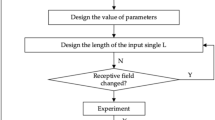Abstract
Convolutional neural networks (CNNs) have been applied to the field of fault diagnosis as one of the most widely used deep learning architectures. Different input modes of CNN for bearing fault identification were analyzed by researchers to improve recognition accuracy, such as time-domain diagram, grayscale diagram, short-time Fourier transform diagram, and continuous wavelet transform diagram. However, for the data with small sample size and high background noise, the performance of the CNN is constrained. In this paper, one CNN input mode for bearing fault recognition is proposed based on time-domain color feature diagram (TDCF) through adding red color to diagrams. The method significantly enhanced the fault characteristics of the signal, which is beneficial to the CNN extraction of bearing fault features. Convolution visualization illustrates the effectiveness of the proposed method that provides more bearing fault recognition information. Different sample size and color rate were analyzed by bearing vibration data with high noise. The results showed that the bearing fault identification method based on CNN with 0.4 TDCF obtained a highest fault identification accuracy compared with other input mode methods. The feasibility of the proposed method has been validated, which also provides one reference for other faults identification and pattern recognition.












Similar content being viewed by others
References
Nandi S, Toliyat HA, Li X (2005) Condition monitoring and fault diagnosis of electrical motors: a review. IEEE Trans Energy Convers 20(4):719–729
Gharesi N, Arefi MM, Ebrahimi Z, Razavi-Far R, Saif M, Zarei J (2018) Analyzing the vibration signals for bearing defects diagnosis using the combination of SGWT feature extraction and SVM. IFAC-PapersOnLine 51(24):221–227
Dunli L, Qian N, Xiaomin Y (2018) Fault diagnosis of rolling bearing based on knn-naive bayesian algorithm. Comput Meas Control 26(6):21–27
Pliego Marugán Alberto, García Márquez Fausto Pedro, Pinar Perez Jesus María, Diego Ruiz-Hernández (2018) A survey of artificial neural network in wind energy systems. Appl Energy 228:1822–1836
Liu F, Lin G, Shen C (2015) Crf learning with cnn features for image segmentation. Pattern Recogn 48(10):2983–2992
Fayek HM, Lech M, Cavedon L (2017) Evaluating deep learning architectures for speech emotion recognition. Neural Netw 92:60–68
Wu S, Wang D (2019) Effect of subject’s age and gender on face recognition results. J Vis Commun Image R 60:116–122
Tamilselvan P, Wang P (2013) Failure diagnosis using deep belief learning based health state classification. Reliab Eng Syst Saf 115(Jul):124–135
Zhang W, Peng G, Li C (2017) Rolling element bearings fault intelligent diagnosis based on convolutional neural networks using raw sensing signal. In: Advances in intelligent information hiding and multimedia signal processing. Springer, Cham, pp 77–84
Lu C, Wang Z, Zhou B (2017) Intelligent fault diagnosis of rolling bearing using hierarchical convolutional network based health state classification. Adv Eng Inform 32:139–151
Chang Y, Chen J, Qu C, Pan T (2020) Intelligent fault diagnosis of wind turbines via a deep learning network using parallel convolution layers with multi-scale kernels. Renew Energ 153:205–213
Hoang D, Kang H (2019) Rolling element bearing fault diagnosis using convolutional neural network and vibration image. Cogn Syst Res 53:42–50
Krizhevsky A, Sutskever I, Hinton G (2012) Imagenet classification with deep convolutional neural networks. Adv Neural Inf Process Syst 25(2):1097–1105
Zhang Y, Xing K, Bai R, Sun D, Meng Z (2020) An enhanced convolutional neural network for bearing fault diagnosis based on time–frequency image. Measurement 157:107667
Zhu Z, Peng G, Chen Y, Gao H (2019) A convolutional neural network based on a capsule network with strong generalization for bearing fault diagnosis. Neurocomputing 323:62–75
Islam MMM, Kim J (2019) Automated bearing fault diagnosis scheme using 2D representation of wavelet packet transform and deep convolutional neural network. Comput Ind 106:142–153
Lecun Y, Boser B, Denker J, Henderson D, Howard R, Hubbard W et al (1989) Backpropagation applied to handwritten zip code recognition. Neural Comput 1(4):541–551
Ji Z, Sun Y, Yu Y, Guo J, Pang Y (2018) Semantic softmax loss for zero-shot learning. Neurocomputing 316:369–375
Zhang J, Sun Y, Guo L, Gao H, Hong X, Song H (2020) A new bearing fault diagnosis method based on modified convolutional neural networks. Chin J Aeronaut 33(2):439–447
Loparo KA (2013) Bearing data center. Case Western Reserve University
Zhou B, Khosla A, Lapedriza A, Oliva A, Torralba A (2016) Learning deep features for discriminative localization. In: 2016 IEEE conference on computer vision and pattern recognition (CVPR), pp 2921–2929
Acknowledgement
The authors gratefully acknowledge the financial support by the National Key Research and Development Program of China (Grant No. 2018YFC0810500).
Author information
Authors and Affiliations
Corresponding author
Additional information
Technical Editor: Wallace Moreira Bessa, D.Sc.
Publisher's Note
Springer Nature remains neutral with regard to jurisdictional claims in published maps and institutional affiliations.
Rights and permissions
About this article
Cite this article
Han, T., Tian, Z., Yin, Z. et al. Bearing fault identification based on convolutional neural network by different input modes. J Braz. Soc. Mech. Sci. Eng. 42, 474 (2020). https://doi.org/10.1007/s40430-020-02561-6
Received:
Accepted:
Published:
DOI: https://doi.org/10.1007/s40430-020-02561-6




